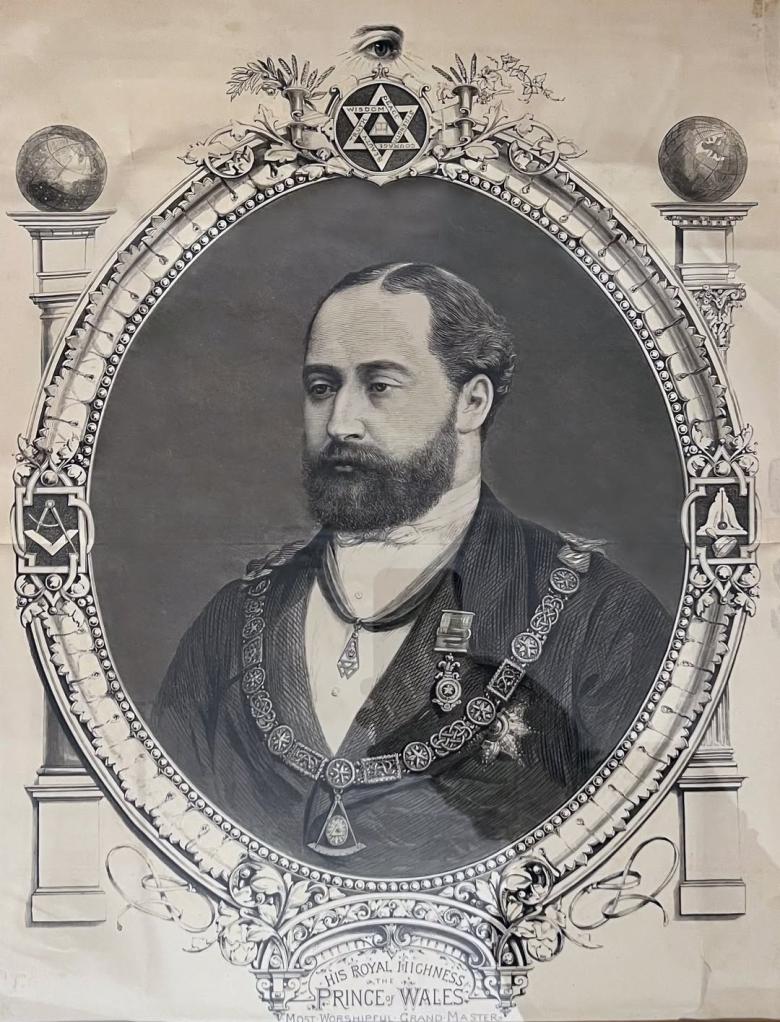A portrait of the future King Edward VII of Great Britain


Some of our latest news
A portrait of the future King Edward VII of Great Britain
This week's object is a portrait of the future King Edward VII of Great Britain (1901-1910) in Masonic Grand Master regalia, made in 1875.
The link between monarchs and Freemasonry is traditional for European countries, especially Protestant monarchies such as Sweden, Denmark and Great Britain. However, this tradition is also found in predominantly Catholic countries such as France. It is important to note that almost always the chief Freemason in European monarchies is the king or a close relative of the queen. The formation of this tradition was greatly influenced by the philosophy of the Enlightenment, the centres of which were Masonic lodges that united the intellectual elite of the 18th century. Through close contacts with the intelligentsia, monarchs embraced the humanist worldview and on this basis developed their policies, including the rudiments of modern economic liberalism and democracy.
One of the first Masonic monarchs was King William III of England (1650-1702), who joined the fraternity as early as the late 17th century, before the founding of the Grand Lodge of England. Because of this, the term «Royal Art» is used in Freemasonry. William III is recognised as one of the most successful English monarchs. It was his liberal economic reforms and the strengthening of the constitutional monarchy that allowed Britain to avoid future upheavals such as the French Revolution and become one of the world's leading powers. This may have been influenced by the king's Masonic worldview, which limited absolute monarchy by law and prevented the emergence of tyranny.
King Edward VII of Great Britain (1841-1910) was the eldest son of Queen Victoria and Prince Albert. Even before the beginning of his royal reign, and serving as the Prince of Wales, Edward had shown himself to be an active diplomat, travelling around the world and meeting with world leaders. In 1860 Edward visited the United States, where he met with President James Buchanan, who was an active Freemason. According to Edward's own recollections, he was primarily attracted to the mysticism and esoteric aspects of Freemasonry.
It is known that the future King Edward VII was admitted to Freemasonry in Sweden on 20 December 1868 in «Juventus» Lodge No. 324, where he attained the tenth degree in the Swedish Ritual. Many factors influenced the Prince of Wales' decision to join Freemasonry, including his desire to strengthen ties with European monarchies, but his primary motivation was his desire to learn the philosophical humanistic teachings of Freemasonry.
After his initiation, Edward became even more active in developing diplomatic ties between the British monarchy and other states, for which he was called a peacemaker even before he came to the throne.
Edward was actively involved in many European lodges. Becoming Grand Master of the Grand Lodge of England in 1874, the prince strengthened the influence of Freemasonry both at home and abroad. Edward regularly participated in meetings of Pan-European Masonic organisations and met with Freemasons of the highest ranks, expanding cultural and economic international ties.
Already a Grand Master, Prince Edward embarked on a long journey across Spain and the Mediterranean, reaching Greece and Egypt. In Greece, Edward met with the related Greek royal family of the Glucksburgs. However, Edward was particularly interested in the heritage of ancient Greece - he studied the works of philosophers, visited ancient sanctuaries and researched the influence of the Mysteries - secret ancient cults on Masonic rituals. Edward also pushed for the opening of the Masonic lodges in Athens, which united all sectors of Greek society, including even the Orthodox clergy.
In Egypt, Edward was struck by the grandiosity of the ancient Egyptian monuments, which, in his opinion, hid the origins of Freemasonry. After Egypt, Prince Edward visited the British possessions in India, where he paid attention to the study of Indian and Zoroastrian religious teachings. All this allows us to characterise Edward as a man with a very rich inner world, with a desire to find links between Masonic teachings and the spiritual heritage of various world religions.
Edward VII became king of Great Britain in 1901. His diplomatic and peace-making aspirations were particularly evident in his successful negotiations with France and Russia, which led to the creation of the Entente, a military and economic alliance based on overcoming national differences. The territory of the Entente countries included Christians of all denominations, Muslims, Buddhists, Hindus and representatives of other religions. This can be considered a manifestation of Masonic philosophy - uniting people with completely different spiritual traditions.
Edward VII maintained close contacts with many Freemasons from various jurisdictions, including representatives of the Grand Orient of France, as well as with German and Swedish Freemasons. Moreover, there is a reason to believe that it was Edward VII who influenced the lifting of the ban on Freemasonry in the Russian Empire. The mother of the last Russian Emperor Nicholas II, Maria Feodorovna, was a sister of Edward VII's wife, Alexandra of Denmark. Although there is no evidence that Nicholas II was a Freemason, he had a friendly relationship with Edward VII, which may have influenced the revival of Russian Freemasonry after 1905.
After the death of Edward VII, the tradition of appointing a representative of the royal family as Grand Master was finally consolidated in Great Britain. From an ideological point of view, this symbolises the unity of people of different political convictions and the fact that the royal authority recognises the need for democratic decisions.
From 1967 to the present days, the Grand Master of the Grand Lodge of England has been Prince Edward, Duke of Kent - great-grandson of Edward VII. He is one of the longest serving Royal Grand Masters, continuing the diplomatic and peace-making work of his ancestors.
 Museum
Museum